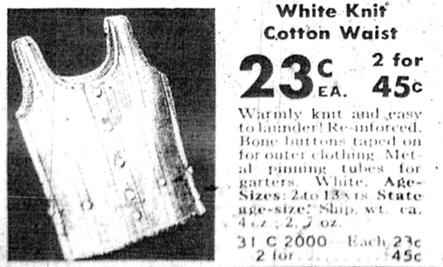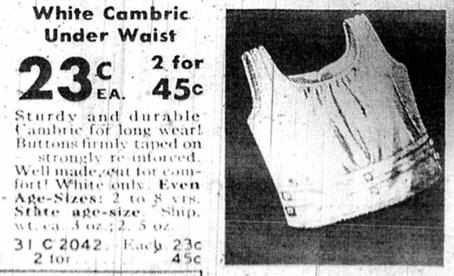
Figure 1.--This is the standard knit underwaist for boys and girls from 2 to 13 years of age. It was a standard underwear item for more than three decades and can be found in most Wards and Sears catalogues from about 1920 to 1950.


Figure 1.--This is the standard knit underwaist for boys and girls from 2 to 13 years of age. It was a standard underwear item for more than three decades and can be found in most Wards and Sears catalogues from about 1920 to 1950. |
We note Ward's Fall and Winter catalogue for 1936-37 (p. 143). This ad shows two kinds of underwaists for boys and girls. The purpose was primarily to hold up long stockings. As long stockings were becoming less common, by the late 1930s you begin to see fewer ads, but throughout the 30s they still appeared in the major catalogs.
Although the word "consumerism" has a modern ring, it was personal concern for an early consumer movement, the "National Grange of the Patrons of Husbandry," That inspired a young traveling salesman named Aaron Montgomery Ward to start the world's first general merchandise mail-order company in 1872. Aaron Montgomery Ward was born on February 17, 1844, in Chatham, New Jersey, to a family whose forebears had served as officers in the French and Indian Wars as well as in the American Revolution. Looking for something more compatible, Monty left home and followed the river to Lake Michigan and the town of St. Joseph, county seat and market for outlying fruit orchards. Chicago was the center of the wholesale dry goods trade and in the 1860s Ward joined the leading dry goods house, Field Palmer & Leiter. As a retailer, Potter Palmer had previously built a reputation for fair dealing. Ward absorbed these principles while working as a clerk for $5. The Chicago City Directories for 1868 through 1870 listed Ward as a salesman for Wills, Greg & Co. and later for Stetthauers & Wineman, both dry goods houses. In 1870, after canvassing territory in Illinois, Iowa, Missouri, Ward was again footloose. The plan shaping in Ward's mind was to buy goods at low cost for cash. By eliminating intermediaries, with their markups and commissions, and cutting selling costs to the bone, he could offer goods to people, however remote, at appealing prices - for cash. Since its founding in 1872, the company has literally "grown up with America" and has had a major impact on the shopping habits of a nation of consumers. Montgomery Ward & Co. discontinued its catalog operations in 1985 as part of its restructuring effort to change itself into a modern, competitive chain of value-driven specialty stores, a move which for a time saved the company. week.
Wards didn't indicate the manufacturer.
Underwaists were another type of support garment. Underwaists (sometimes called panty-waists) were worn by younger boys and girls to support additional underwear (such as bloomers or panties) or outer clothing (such as trousers or skirts). These bodices tended to be worn by boys only until about age 10, although some models came in ages for boys as old as 12. Some models were specifically for girls and others for boys, but the great majority of styles could be worn by both boys and girls. They tended to be made of elastic knitted fabric (and therefore rather form-fitting) or of cambric material and a bit looser. They nearly always were equipped with reinforcement straps, waist buttons, and garter tabs for attaching hose supporters. The popularity of underwaists declined in the later 1930s and early 1940s although they were still available, usually in the preferred knitted style, up until about 1945. When long stockings stopped being worn by school children, the main function of the underwaist ceased to exist.

Figure 2.-- 3 oz; 2, 5 oz. 31 C 2042 Each 23 c.; 2 for 45 c. [HBC note: This cambric waist was made for smaller children, both boys and girls (2 to 8 years old). It is of lighter weight than the waist shown to the left (perhaps more comfortable for warmer weather) and, being of non-knit fabric, is non-elastic and looser fitting. |
We note Ward's Fall and Winter catalogue for 1936-37 (p. 143). This ad shows two kinds of underwaists for boys and girls. The purpose was primarily to hold up long stockings. As long stockings were becoming less common, by the late 1930s you begin to see fewer ads, but throughout the 30s they still appeared in the major catalogs.
The Wards ad copy read, "White Knit Cotton Waist 23 cents each. 2 for 45 cents. Warmly knit and easy to launder! Reinforced Bone buttons taped on for outer clothing. Metal pinning tubes for garters. White. Age-Sizes 2 to 13 years. State age-size. Shipping weight each 4 oz.; 2, 7 oz. 31 C 2000 Each 23 c. 2 for 45 c."
[HBC note: This is the standard knit underwaist for boys and girls from 2 to 13 years of age. It was a standard underwear item for more than three decades and can be found in most Wards and Sears catalogues from about 1920 to 1950. It buttons down the front and has waist bone waist buttons around the waistline for buttoning on short trousers, skirts, bloomers, or panties. It serves also as an additional layer of underwear over the chest for children in
the colder climates. The metal pinning tubes for hose supporters are attached to the sides so that the garters can be worn over the hips. Underwaists such as these were an alternative to garter waists or waist union suits as a means of supporting long stockings. They are sold without supporters attached. The garters would be purchased separately. Note that children as old as 13 years wore them. Note the wide arm openings to allow for athletic movement in growing children.]
The wards ad copy read, "White Cambric Under Waist 23 cents each. 2 for 45 cents. Sturdy and durable Cambric for long wear! Buttons firmly taped on and strongly reinforced. Well made, cut for comfort! White only. Even Age-Sizes: 2 to 8 years. State age-size. Ship. weight each 3 oz; 2, 5 oz. 31 C 2042 Each 23 c.; 2 for 45 c.
[HBC note: This cambric waist was made for smaller children, both boys and girls (2 to 8 years old). It is of lighter weight than the waist shown to the left (perhaps more comfortable for warmer weather) and, being of non-knit fabric, is non-elastic and looser fitting. It buttons down the back and has a gathered front to allow for growing chests. It has the same kind of buttons around the waistline for the attachment of additional clothing as its companion, the knitted waist. It also has garter tabs at the sides for the
attachment of hose supporters. Although the text does not tell us precisely, these seem to be metal pinning tubes rather than tape loops.]
Navigate the Boys' Historical Clothing catalog/magazine pages:
[Return to the Main American mail order 1936 page]
[Return to the Main American mail order 1930s page]
[Main photo/publishing page]
[Store catalogs]
[Fashion magazines]
Navigate the Boys' Historical Clothing Web Site:
[Main U.S. page]
[Main U.S. 1930s page]
[Introduction]
[Activities]
[Biographies]
[Chronology]
[Cloth and textiles]
[Clothing styles]
[Countries]
[Topics]
[Bibliographies]
[Contributions]
[FAQs]
[Glossaries]
[Satellite sites]
[Tools]
[Boys' Clothing Home]
Navigate the Boys' Historical Clothing Web Site:
[Sailor suits]
[Sailor hats]
[Buster Brown suits]
[Knickers]
[Short pants]
[Eton suits]
[Rompers]
[Tunics]
[Smocks]
[Tights]
[Long stockings]
[Stocking supporters]
[Underwear]
